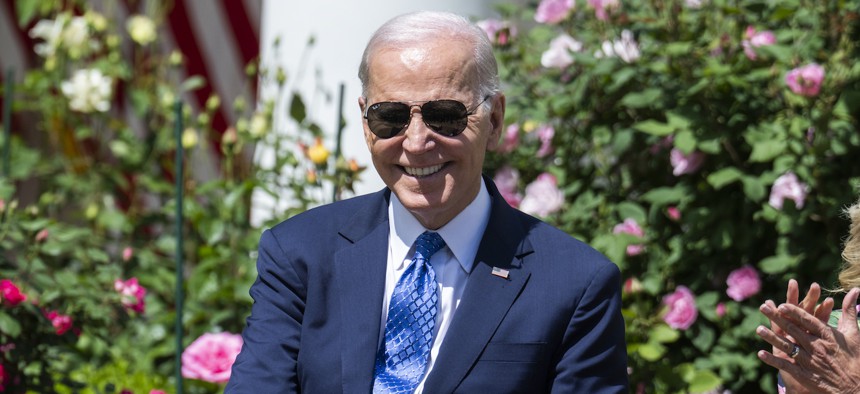
President Joe Biden at an event in the White House Rose Garden on April 24, 2023. On Tuesday he announced his relection bid for the presidency. Tom Williams/CQ-Roll Call, Inc via Getty Images
What Might a Second Biden Term Mean for Feds? Here’s a Look at The First
Revoking Schedule F, boosting diversity and equity, and restoring scientific integrity has been some of the Biden administration's accomplishments and goals.
President Biden took office in January 2021 seeking to restore and revitalize the federal workforce after the previous administration took big swings at it. Now he’s running for reelection and stated during his launch video posted on Tuesday morning that he seeks to “finish the job” of standing up for democracy, freedom and equity.
Behind Biden is a federal workforce of more than 2 million, including the career civil service and political appointees. Here is a non-exhaustive list of what he’s done for federal employees over the last17 months:
Biden said during the 2020 campaign he sought to rebuild the federal workforce that was “hollowed out” by President Trump. However, there has only been a slight increase in the total federal workforce. Growing the workforce has been a difficult process, as Government Executive reported in a multi-part series in March that looked at the State Department's success and the Interior Department's “glacial.. pace of action.”
Meanwhile, due to the Inflation Reduction Act, signed by Biden in August 2022, the Internal Revenue Service will be able to rebuild and reinvigorate its workforce. Overall, the IRS plans to spend approximately $47 billion on tax enforcement efforts, $7.5 billion on taxpayer services, $12 billion technology improvements, $4 billion on energy security and $8 billion on hiring and retention.
Biden revoked Schedule F, a Trump-era executive order aimed at stripping federal employees of their civil service protections. However, conservative activists seek to bring it back if a Republican wins in 2024.
Biden has claimed to be “the most pro-labor president” in recent history and federal employee union leaders point to positive change with the Biden administration following the Trump administration. However, one source of tension has been the return to office following the maximum telework status for the pandemic.
In his budget request for fiscal 2024 released in March, Biden proposed a 5.2% average pay raise for both civilian federal employees and military service members, the highest proposed increase since the Carter administration. Yet, some congressional Democrats and federal employee groups seek a higher rate.
Biden issued an executive order in June 2021 seeking to increase diversity, equity, inclusion and accessibility in the federal workforce. He has also issued two executive orders on using the power of the federal government to advance racial equity and support underserved communities.
Biden and other top officials have consistently touted the vast diversity in Biden’s Cabinet, political appointees and judicial nominees. However, as outlined in a report released last September by the Joint Center for Political and Economic Studies, Black people made up 22% of Biden’s voters in November 2020, yet are only 11% of White House commissioner officers.
The Biden administration established a Safer Federal Workforce Task Force as part of efforts to protect federal employees and contractors from COVID-19. Later in 2021, Biden issued vaccine mandates for both groups, but they faced many legal challenges, and currently are not being enforced.
The Office of Management and Budget sent a memo to agencies in December 2021 about how to best cooperate and communicate with their inspectors general, following concerns in recent years that agencies weren’t fully compliant with their watchdog’s requests.
For implementation of the American Rescue Plan, OMB and White House officials started “gold standard meetings” with agency officials, IGs and Pandemic Response Accountability Committee leadership to mitigate fraud on the front end.
The Biden administration has taken various actions to protect federal scientists from political retribution and restriction, as this was an issue during the prior administration. However, some advocates have warned that they haven’t gone far enough.
To date, two other Democrats and five Republicans – including the recently indicted Trump –have declared their candidacy for president. At least five other Republicans may decide to run, according to The Washington Post’s tracker. Election day is Nov. 5, 2024.







